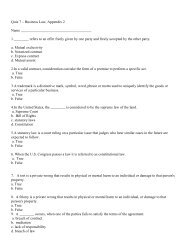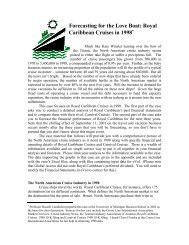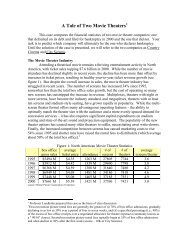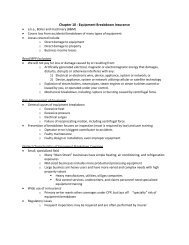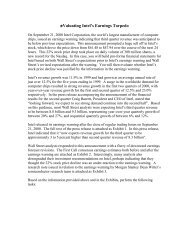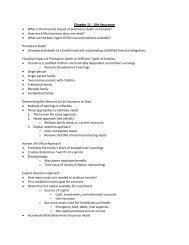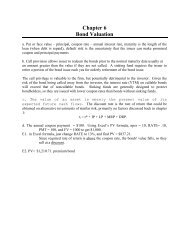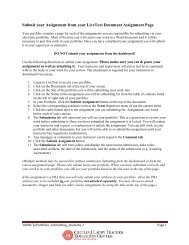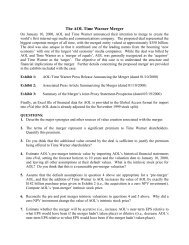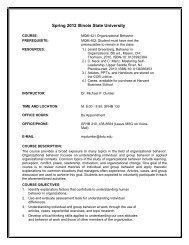Evaluating a Firm's External Environment - Illinois State University
Evaluating a Firm's External Environment - Illinois State University
Evaluating a Firm's External Environment - Illinois State University
Create successful ePaper yourself
Turn your PDF publications into a flip-book with our unique Google optimized e-Paper software.
M02_BARN4586_03_SE_C02.qxd 7/1/09 7:34 AM Page 61<br />
Chapter 2: <strong>Evaluating</strong> a Firm’s <strong>External</strong> <strong>Environment</strong> 61<br />
Challenge Questions<br />
1. Your former college roommate calls<br />
you and asks to borrow $10,000 so that<br />
he can open a pizza restaurant in his<br />
hometown. In justifying this request, he<br />
argues that there must be significant<br />
demand for pizza and other fast food in<br />
his hometown because there are lots of<br />
such restaurants already there and<br />
three or four new ones are opening each<br />
month. He also argues that demand for<br />
convenience food will continue to<br />
increase, and he points to the large<br />
number of firms that now sell frozen<br />
dinners in grocery stores. Will you lend<br />
him the money? Why or why not?<br />
2. According to the five forces model,<br />
one potential threat in an industry is<br />
buyers. Yet unless buyers are satisfied,<br />
they are likely to look for satisfaction<br />
elsewhere. Can the fact that buyers can<br />
be threats be reconciled with the need<br />
to satisfy buyers?<br />
3. Government policies can have a<br />
significant impact on the average profitability<br />
of firms in an industry. Government,<br />
however, is not included as a<br />
potential threat in the five forces<br />
model. Should the model be expanded<br />
to include government (to make a “six<br />
forces” model)? Why or why not?<br />
4. How would you add complementors<br />
to the five forces model? In particular,<br />
if an industry has large numbers<br />
of complementors, does that make it<br />
more attractive, less attractive, or does<br />
it have no impact on the industry’s<br />
attractiveness? Justify your answer.<br />
5. Opportunities analysis seems to<br />
suggest that strategic opportunities<br />
are available in almost any industry,<br />
including declining ones. If that is true,<br />
is it fair to say that there is really no<br />
such thing as an unattractive industry?<br />
If yes, what implications does this<br />
have for the five forces model? If no,<br />
describe an industry that has no<br />
opportunities.<br />
6. Is the evolution of industry structure<br />
from an emerging industry to a<br />
mature industry to a declining industry<br />
inevitable? Why or why not?<br />
Problem Set<br />
1. Perform a five forces analysis on the following two industries:<br />
The Pharmaceutical Industry<br />
The pharmaceutical industry consists of firms that develop, patent, and distribute drugs.<br />
Although this industry does not have significant production economies, it does have<br />
important economies in research and development. Product differentiation exists as well,<br />
because firms often sell branded products. Firms compete in research and development.<br />
However, once a product is developed and patented, competition is significantly reduced.<br />
Recently, the increased availability of generic, nonbranded drugs has threatened the profitability<br />
of some drug lines. Once an effective drug is developed, few, if any, alternatives to<br />
that drug usually are available. Drugs are manufactured from commodity chemicals that<br />
are available from numerous suppliers. Major customers include doctors and patients.<br />
Recently, increased costs have led the federal government and insurance companies to<br />
pressure drug companies to reduce their prices.<br />
The Textile Industry<br />
The textile industry consists of firms that manufacture and distribute fabrics for use in<br />
clothing, furniture, carpeting, and so forth. Several firms have invested heavily in sophisticated<br />
manufacturing technology, and many lower-cost firms located in Asia have begun<br />
fabric production. Textiles are not branded products. Recently, tariffs on some imported<br />
textiles have been implemented. The industry has numerous firms; the largest have less<br />
than 10 percent market share. Traditional fabric materials (such as cotton and wool) have<br />
recently been threatened by the development of alternative chemical-based materials (such<br />
as nylon and rayon), although many textile companies have begun manufacturing with<br />
these new materials as well. Most raw materials are widely available, although some



